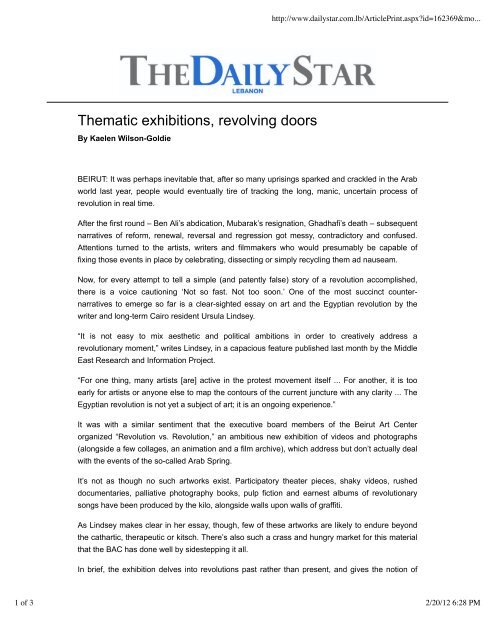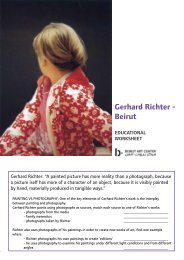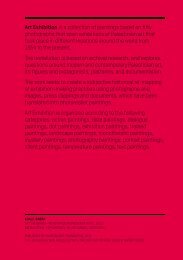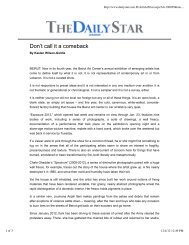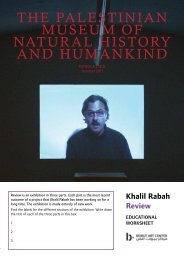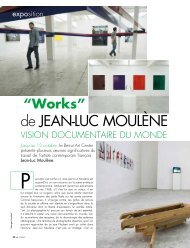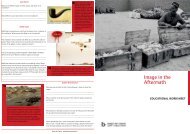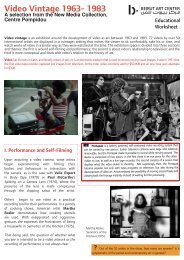Thematic exhibitions, revolving doors - Beirut Art Center
Thematic exhibitions, revolving doors - Beirut Art Center
Thematic exhibitions, revolving doors - Beirut Art Center
You also want an ePaper? Increase the reach of your titles
YUMPU automatically turns print PDFs into web optimized ePapers that Google loves.
http://www.dailystar.com.lb/<strong>Art</strong>iclePrint.aspxid=162369&mo...<br />
<strong>Thematic</strong> <strong>exhibitions</strong>, <strong>revolving</strong> <strong>doors</strong><br />
By Kaelen Wilson-Goldie<br />
BEIRUT: It was perhaps inevitable that, after so many uprisings sparked and crackled in the Arab<br />
world last year, people would eventually tire of tracking the long, manic, uncertain process of<br />
revolution in real time.<br />
After the first round – Ben Ali’s abdication, Mubarak’s resignation, Ghadhafi’s death – subsequent<br />
narratives of reform, renewal, reversal and regression got messy, contradictory and confused.<br />
Attentions turned to the artists, writers and filmmakers who would presumably be capable of<br />
fixing those events in place by celebrating, dissecting or simply recycling them ad nauseam.<br />
Now, for every attempt to tell a simple (and patently false) story of a revolution accomplished,<br />
there is a voice cautioning ‘Not so fast. Not too soon.’ One of the most succinct counternarratives<br />
to emerge so far is a clear-sighted essay on art and the Egyptian revolution by the<br />
writer and long-term Cairo resident Ursula Lindsey.<br />
“It is not easy to mix aesthetic and political ambitions in order to creatively address a<br />
revolutionary moment,” writes Lindsey, in a capacious feature published last month by the Middle<br />
East Research and Information Project.<br />
“For one thing, many artists [are] active in the protest movement itself ... For another, it is too<br />
early for artists or anyone else to map the contours of the current juncture with any clarity ... The<br />
Egyptian revolution is not yet a subject of art; it is an ongoing experience.”<br />
It was with a similar sentiment that the executive board members of the <strong>Beirut</strong> <strong>Art</strong> <strong>Center</strong><br />
organized “Revolution vs. Revolution,” an ambitious new exhibition of videos and photographs<br />
(alongside a few collages, an animation and a film archive), which address but don’t actually deal<br />
with the events of the so-called Arab Spring.<br />
It’s not as though no such artworks exist. Participatory theater pieces, shaky videos, rushed<br />
documentaries, palliative photography books, pulp fiction and earnest albums of revolutionary<br />
songs have been produced by the kilo, alongside walls upon walls of graffiti.<br />
As Lindsey makes clear in her essay, though, few of these artworks are likely to endure beyond<br />
the cathartic, therapeutic or kitsch. There’s also such a crass and hungry market for this material<br />
that the BAC has done well by sidestepping it all.<br />
In brief, the exhibition delves into revolutions past rather than present, and gives the notion of<br />
1 of 3 2/20/12 6:28 PM
http://www.dailystar.com.lb/<strong>Art</strong>iclePrint.aspxid=162369&mo...<br />
political trauma a historical and notably international cast.<br />
With 14 bodies of work by 14 artists deep in the ruptured seams of apartheid South Africa,<br />
China’s Cultural Revolution, Iran’s Islamic Revolution, the fall of the Berlin Wall, the collapse of<br />
the Soviet Union and the devastating push and pull of Cold War politics in Central and South<br />
America, the show is a knockout, even if it skirts around its many possible subjects and never<br />
quite coheres along a common theme.<br />
The show includes the masterful “marxism today (prologue),” a 35-minute video by artist Phil<br />
Collins, who previously filmed gangly teenagers doing a dance marathon in Ramallah, and more<br />
gangly teenagers doing karaoke in Istanbul, Bogota and Jakarta (to The Smiths, no less).<br />
Interspersed with eerie archival footage, “marxism today” runs through three piercing interviews<br />
with women who taught Marxist-Leninist political economy at elite universities and vocational<br />
schools in the German Democratic Republic before it disappeared.<br />
The first woman, whose hero was Nelson Mandela and whose ambition was to join the African<br />
National Congress, endures the suicide of her husband, who breaks down while waiting for a<br />
travel visa.<br />
Having lost her partner, her country and her job, she decides to be retrained as a social worker<br />
(her other option was banking, which would have been a disaster, she says, because she would<br />
have given all the money away). Only then – settled in an occupation that allows her to help<br />
people – does she find any meaning in her life again.<br />
The second woman marries one of her students and does become a banker. “It was no more a<br />
question of how to create a society and an economy that serves the people,” she says. “But you<br />
can become rich.” She did that.<br />
“The sad thing is that now my life is just about consuming and earning money,” she adds. “It’s a<br />
bit poor.”<br />
She looks back on her education via Marx and Lenin, particularly its emphasis on critical thinking,<br />
as a gift. “Just by learning their method,” she says, “windows opened and fresh air came in.”<br />
The third woman wants out of politics and starts a dating agency. Her story, however, is as much<br />
about her daughter, a gymnast who stopped competing when the wall fell in 1989. At that point,<br />
she was an 18-year-old who had never dated or been to a disco, who wanted to get on with her<br />
life and suddenly found herself in a body, 20 kilos heavier, completely strange and unknown to<br />
her.<br />
The strands of loss and longing that run through “marxism today” lend “Revolution vs.<br />
Revolution” a subtext.<br />
Tacita Dean’s moving installation of a wooden table and chair with a boxful of small blackand-white<br />
prints of photographs she took 20 years ago in Prague is as much about the aftermath<br />
of the Velvet Revolution as it is about the obsolescence of film.<br />
2 of 3 2/20/12 6:28 PM
http://www.dailystar.com.lb/<strong>Art</strong>iclePrint.aspxid=162369&mo...<br />
Francis Alys’ video “When Faith Moves Mountains” documents a project of the same title, for<br />
which he recruited 500 students to shovel a sand dune 10 centimeters to one side. The project<br />
depends on a strategy of political mobilization and collective spirit that is familiar to South<br />
American politics but no longer operative or motivated by common cause.<br />
“So in fact, we’ve got other projects,” one student jokes at the end of the video, “things like ...<br />
Drink the Atlantic. Melt the Antarctic. Paint the sky.”<br />
What keeps this show from falling into the ditch of nostalgia is the striking poetry of Fadi<br />
al-Abdallah (the crucial and not entirely unexpected exception to the “No Arab Spring” rule) and<br />
the grit that comes from Susan Meiselas’ photographic projects in Nicaragua – which touch all of<br />
the sensitive nerves of accountability and crime.<br />
The same can be said of the hide and seek game of reading David Goldblatt’s photographs of<br />
South African landscapes, with their traces of one crisis (apartheid) subsumed by another (the<br />
AIDS epidemic).<br />
“Revolution vs. Revolution” is part of a larger, longer-term effort on the part of the <strong>Beirut</strong> <strong>Art</strong><br />
<strong>Center</strong> to create a survey of trenchant artistic strategies (particularly resonant for local artists<br />
whose work grapples with Lebanon’s political history) alongside a sampling of terrific, high-caliber<br />
contemporary artworks (which are both a pleasure and a gift to the general public).<br />
Over the past three years, the BAC has mounted three major thematic shows: “America,” “Image<br />
in the Aftermath” and “Revolution vs. Revolution.” Emphasizing traumatic events, unintended<br />
consequences and a putative enemy, these shows are all, in a way, the same – the downside of<br />
curating by committee and consensus – to the extent that one could shuffle the works around<br />
and make three different shows without dislodging any one theme.<br />
Greater precision and a little more depth would make subsequent <strong>exhibitions</strong> more distinct. But<br />
for now, the works are more than enough to make us think.<br />
“Revolution vs. Revolution” is on view at the <strong>Beirut</strong> <strong>Art</strong> <strong>Center</strong> in Jisr al-Wati through March 30.<br />
For more information, please see www.beirutartcenter.org or call 01-397-018.<br />
Copyrights 2011, The Daily Star - All Rights Reserved<br />
07/02/2012<br />
3 of 3 2/20/12 6:28 PM


